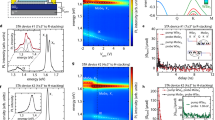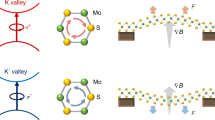Abstract
The valley degree of freedom of electrons in solids has been proposed as a new type of information carrier, beyond the electron charge and spin1,2,3,4,5,6. The potential of two-dimensional semiconductor transition metal dichalcogenides in valley-based electronic and optoelectronic applications has recently been illustrated through experimental demonstrations of the optical orientation of the valley polarization7,8,9,10 and of the valley Hall effect11 in monolayer MoS2. However, the valley Hall conductivity in monolayer MoS2, a non-centrosymmetric crystal, cannot be easily tuned, which presents a challenge for the development of valley-based applications. Here, we show that the valley Hall effect in bilayer MoS2 transistors can be controlled with a gate voltage. The gate applies an electric field perpendicular to the plane of the material, breaking the inversion symmetry present in bilayer MoS2. The valley polarization induced by the longitudinal electrical current was imaged with Kerr rotation microscopy. The polarization was found to be present only near the edges of the device channel with opposite sign for the two edges, and was out-of-plane and strongly dependent on the gate voltage. Our observations are consistent with symmetry-dependent Berry curvature and valley Hall conductivity in bilayer MoS212.
This is a preview of subscription content, access via your institution
Access options
Subscribe to this journal
Receive 12 print issues and online access
$259.00 per year
only $21.58 per issue
Buy this article
- Purchase on Springer Link
- Instant access to full article PDF
Prices may be subject to local taxes which are calculated during checkout




Similar content being viewed by others
References
Rycerz, A., Tworzydło, J. & Beenakker, C. W. J. Valley filter and valley valve in graphene. Nature Phys. 3, 172–175 (2007).
Akhmerov, A. R. & Beenakker, C. W. J. Detection of valley polarization in graphene by a superconducting contact. Phys. Rev. Lett. 98, 157003 (2007).
Xiao, D., Yao, W. & Niu, Q. Valley-contrasting physics in graphene: magnetic moment and topological transport. Phys. Rev. Lett. 99, 236809 (2007).
Gunawan, O. et al. Valley susceptibility of an interacting two-dimensional electron system. Phys. Rev. Lett. 97, 186404 (2006).
Xiao, D., Liu, G.-B., Feng, W., Xu, X. & Yao, W. Coupled spin and valley physics in monolayers of MoS2 and other group-VI dichalcogenides. Phys. Rev. Lett. 108, 196802 (2012).
Xu, X., Yao, W., Xiao, D. & Heinz, T. F. Spin and pseudospins in layered transition metal dichalcogenides. Nature Phys. 10, 343–350 (2014).
Mak, K. F., He, K., Shan, J. & Heinz, T. F. Control of valley polarization in monolayer MoS2 by optical helicity. Nature Nanotech. 7, 494–498 (2012).
Zeng, H., Dai, J., Yao, W., Xiao, D. & Cui, X. Valley polarization in MoS2 monolayers by optical pumping. Nature Nanotech. 7, 490–493 (2012).
Cao, T. et al. Valley-selective circular dichroism of monolayer molybdenum disulphide. Nature Commun. 3, 887 (2012).
Sallen, G. et al. Robust optical emission polarization in MoS2 monolayers through selective valley excitation. Phys. Rev. B 86, 081301(R) (2012).
Mak, K. F., McGill, K. L., Park, J. & McEuen, P. L. The valley Hall effect in MoS2 transistors. Science 344, 1489–1492 (2014).
Wu, S. et al. Electrical tuning of valley magnetic moment through symmetry control in bilayer MoS2 . Nature Phys. 9, 149–153 (2013).
Gorbachev, R. V. et al. Detecting topological currents in graphene superlattices. Science 346, 448–451 (2014).
Sui, M. et al. Gate-tunable topological valley transport in bilayer graphene. Nature Phys. 11, 1027–1031 (2015).
Shimazaki, Y. et al. Generation and detection of pure valley current by electrically induced Berry curvature in bilayer graphene. Nature Phys. 11, 1032–1036 (2015).
Lensky, Y. D., Song, J. C. W., Samutpraphoot, P. & Levitov, L. S. Topological valley currents in gapped Dirac materials. Phys. Rev. Lett. 114, 256601 (2015).
Mak, K. F., Lee, C., Hone, J., Shan, J. & Heinz, T. F. Atomically thin MoS2: a new direct-gap semiconductor. Phys. Rev. Lett. 105, 136805 (2010).
Splendiani, A. et al. Emerging photoluminescence in monolayer MoS2 . Nano Lett. 10, 1271–1275 (2010).
Liu, G. B., Shan, W.-Y., Yao, Y., Yao, W. & Xiao, D. Three-band tight-binding model for monolayers of group-VIB transition metal dichalcogenides. Phys. Rev. B 88, 085433 (2013).
Kośmider, K., González, J. W. & Fernández-Rossier, J. Large spin splitting in the conduction band of transition metal dichalcogenide monolayers. Phys. Rev. B 88, 245436 (2013).
Cheiwchanchamnangij, T. & Lambrecht, W. R. L. Quasiparticle band structure calculation of monolayer, bilayer, and bulk MoS2 . Phys. Rev. B 85, 205302 (2012).
Kato, Y. K., Myers, R. C., Gossard, A. C. & Awschalom, D. D. Observation of the spin Hall effect in semiconductors. Science 306, 1910–1913 (2004).
Sih, V. et al. Spatial imaging of the spin Hall effect and current-induced polarization in two-dimensional electron gases. Nature Phys. 1, 31–35 (2005).
Gong, Z. et al. Magnetoelectric effects and valley-controlled spin quantum gates in transition metal dichalcogenide bilayers. Nature Commun. 4, 2053 (2013).
Radisavljevic, B., Radenovic, A., Brivio, J., Giacometti, V. & Kis, A. Single-layer MoS2 transistors. Nature Nanotech. 6, 147–150 (2011).
Tan, Y.-W. et al. Measurement of scattering rate and minimum conductivity in graphene. Phys. Rev. Lett. 99, 246803 (2007).
Malard, L. M., Alencar, T. V., Barboza, A. P. M., Mak, K. F. & de Paula, A. M. Observation of intense second harmonic generation from MoS2 atomic crystals. Phys. Rev. B 87, 201401(R) (2013).
Li, Y. et al. Probing symmetry properties of few-layer MoS2 and h-BN by optical second-harmonic generation. Nano Lett. 13, 3329–3333 (2013).
Biss, D. P. & Brown, T. G. Polarization-vortex-driven second-harmonic generation. Opt. Lett. 28, 923–925 (2003).
Abergel, D. S. L., Russell, A. & Fal'Ko, V. I. Visibility of graphene flakes on a dielectric substrate. Appl. Phys. Lett. 91, 063125 (2007).
Mak, K. F. et al. Tightly bound trions in monolayer MoS2 . Nature Mater. 12, 207–211 (2013).
Lee, C. et al. Anomalous lattice vibrations of single- and few-layer MoS2 . ACS Nano 4, 2695–2700 (2010).
Lüpke, G. et al. Optical second-harmonic generation as a probe of electric-field-induced perturbation of centrosymmetric media. Opt. Lett. 20, 1997–1999 (1995).
Acknowledgements
This work was supported by the U.S. Department of Energy, Office of Basic Energy Sciences under contract No. DESC0013883 (K.F.M.) and the Air Force Office of Scientific Research under grant FA9550-14-1-0268 (J.S.). Kerr rotation microscopy was supported by the National Science Foundation under Award No. DMR-1410407 and 1420451.
Author information
Authors and Affiliations
Contributions
All authors conceived and designed the experiments, analyzed the data, and co-wrote the manuscript. J.L. fabricated the MoS2 FET devices and performed the measurements.
Corresponding authors
Ethics declarations
Competing interests
The authors declare no competing financial interests.
Supplementary information
Supplementary information
Supplementary information (PDF 2377 kb)
Rights and permissions
About this article
Cite this article
Lee, J., Mak, K. & Shan, J. Electrical control of the valley Hall effect in bilayer MoS2 transistors. Nature Nanotech 11, 421–425 (2016). https://doi.org/10.1038/nnano.2015.337
Received:
Accepted:
Published:
Issue Date:
DOI: https://doi.org/10.1038/nnano.2015.337
This article is cited by
-
Giant spin Hall effect in AB-stacked MoTe2/WSe2 bilayers
Nature Nanotechnology (2024)
-
Excitonic devices based on two-dimensional transition metal dichalcogenides van der Waals heterostructures
Frontiers of Chemical Science and Engineering (2024)
-
Intrinsic spin Hall torque in a moiré Chern magnet
Nature Physics (2023)
-
Gapless edge states localized to odd/even layers of AA′-stacked honeycomb multilayers with staggered AB-sublattice potentials
Scientific Reports (2023)
-
Quantized valley Hall response from local bulk density variations
Communications Physics (2023)



